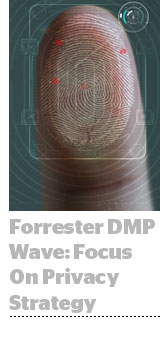
Forrester’s 2019 DMP Wave focused on how data-management platforms plan to make their products more privacy-safe in an environment with increased pressure from privacy regulation as well as Apple ITP and Firefox ETP.
Because of the amount of change going on in the DMP landscape, the analyst firm gave particular weight to a company’s vision.
The Wave named seven top DMPs. But only Salesforce and Adobe landed in the innermost circle of the wave, reserved for those with the strongest current offering and strongest strategy.
Neustar and Nielsen followed, with scores right on the line between “strong performers” and “leaders” in the category. Their current offerings were deemed just as strong as Salesforce and Adobe, but both were dinged based on their future strategy.
“We really wanted to concentrate on understanding where the vendors saw DMPs going in the future,” said Tina Moffett, senior analyst at Forrester Research and a co-author of the DMP Wave.
The DMP leaders – Salesforce Audience Studio and Adobe Audience Manager – were rewarded for their focus on privacy by design and consent management.
“Salesforce and Adobe’s goal is to build a privacy-first consent management, with known customer identifiers to facilitate known customer advertising,” Moffett said. Salesforce came to the market with a strong message around the need for advertisers to build consent management capabilities, she added.
DMPs aren’t dead
To the observer, DMPs may seem to be in the midst of an identity crisis – with new acronyms like customer data platforms (CDPs) chipping away at their perceived usefulness. On the contrary, Forrester is advising marketers that a DMP is a critical connective piece of the omnichannel marketing puzzle. “Audience data will be the underlying foundation of a customer identity within an organization,” Moffett said.
DMPs help bridge different types of data. Its key features include the ability to upload and anonymize first-party data, to build audience profiles and look-alike models, and to buy digital media against the audience you’ve created, Moffett said.
Secondary features: measurement, second-party data
While Salesforce and Adobe are focused on managing identity in a privacy-by-design way, Neustar and Nielsen focus on measurement.
“[Nielsen and Neustar] are bridging the gap between media insights and audience insights, allowing marketers to look at the potential ROI of a segment they’re targeting against.”
Meanwhile Moffett called out Lotame as having the strongest offering for publishers.
“Because they have built their DMP with the publisher in mind, they have a really strong second-party data marketplace, and they are doing that because they think the third-party cookie is under threat, and the quality of publisher data is better,” Moffett said.
In the Wave, Lotame landed on the line between “strong performers” and “contenders.” Oracle was in the “strong performer” section, reflecting a weaker current product but a stronger strategy relative to Lotame.
Oracle customers who spoke with Forrester were concerned about how it was “future-proofing” its data marketplace, which focuses on third-party data. Oracle’s DMP also got weak marks in device identification and data analysis.
In the final ring, a DMP with a strong focus on the European market, the ADEX, finished last in the “contender” category, with a “straightforward” offering that can suit clients in Europe and the Asia-Pacific region.
The number of DMPs in the Wave has shrunk over the past two years, from 11 to seven companies. A previous 2017 DMP Wave included DMPs that are part of companies more known for their DSP capabilities. The 2019 Wave required that the DMP be available as a stand-alone product.
The Wave breakdown:
Use Salesforce for DMP connections to email and the promise of message sequencing and using insights for omnichannel advertising
Use Adobe for the ease of using DMP insights to inform other parts of the customer experience.
Use Neustar if you need performance marketing analytics and strong identity resolution.
Use Nielsen if you care most about measuring media effectiveness, and you’re a CPG, retailer, media owner or automotive manufacturer.
Use Oracle if you need a lot of third-party data to reach customers.
Use Lotame for its publisher data marketplace and client service.
Use ADEX for simple use cases outside of the US market.
This post was syndicated from Ad Exchanger.


More Stories
Citigroup Scales Back DEI Initiatives
Ticker: CBS News Tweaks Format of CBS Evening News
Wednesday, Feb. 19 Evening Cable News Ratings: Jesse Watters Primetime Wins in Adults 25-54